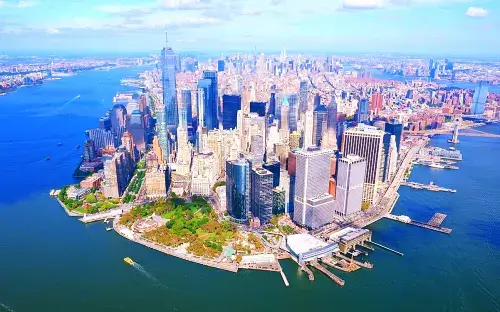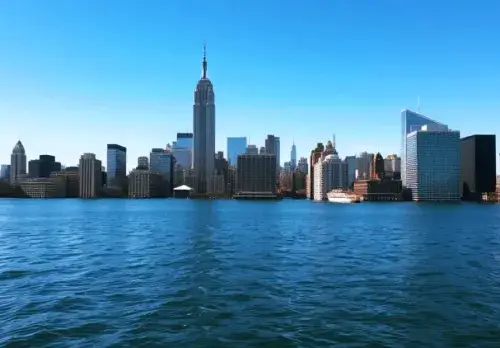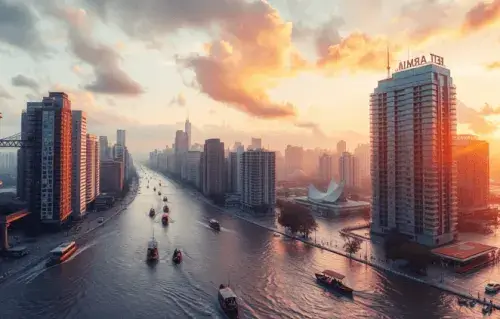New York. For decades, New York City has stood as a symbol of modern civilization, towering skyscrapers, iconic bridges spanning the Hudson River, and the dazzling lights of Times Square have defined it as a monument to human ambition and progress.
It’s hard to imagine this global metropolis as vulnerable. Yet, behind the bustling streets and architectural marvels lies a mounting threat that scientists warn is becoming more real each year: the very ocean that surrounds New York may one day engulf it.
And no, this isn’t the plot of a dystopian movie!
New York and Climate Change and Rising Sea Levels.
One of the most immediate and critical threats to New York City is rising sea levels caused by climate change. According to the National Oceanic and Atmospheric Administration (NOAA), sea levels around New York have risen by nearly 12 inches (about 30 centimeters) since 1900.
This might not seem dramatic at first glance, but the pace is accelerating and that’s where the real danger lies. The primary contributors to rising sea levels are the melting of polar ice sheets in Greenland and Antarctica, along with the thermal expansion of seawater as the ocean warms.
Based on current projections, sea levels could rise an additional 2 to 6 feet (60 to 180 centimeters) by the end of the 21st century, depending on how emissions and global temperatures evolve.
Even a small increase in sea level heightens the risk of destructive flooding, storm surges, and coastal erosion.
Hurricane Sandy in 2012 offered a chilling preview of what the future could hold. It flooded large parts of Lower Manhattan, knocked out the subway system, and left millions without power. Damages totaled an estimated $70 billion.
Events like Sandy could become increasingly frequent if sea levels continue to rise, turning what was once a “once-in-a-century” storm into a regular occurrence.
The City is Sinking.
As if rising water levels weren’t enough, there’s another less-known but equally alarming factor at play: New York City is slowly sinking.
This phenomenon, known as subsidence, is largely a result of human activity. Decades of groundwater extraction, heavy infrastructure, and the sheer weight of the city’s buildings have compressed the underlying soil and rock, causing the land to gradually settle.
Research published in Science Advances shows that the city is sinking at an average rate of 1 to 2 millimeters per year. While that may sound minimal, when combined with rising sea levels, the effect becomes compounded. Areas that were once considered safe from flooding could eventually fall within flood zones.
Certain areas are subsiding faster than others. For example, neighborhoods built on artificial landfill or soft soil are especially at risk.
As the ground sinks and the sea rises, New York finds itself caught in a pincer movement of natural and man-made forces.
Efforts to Defend the City.
In response to these mounting threats, city planners and environmental experts have begun implementing a variety of defense strategies.
Following the devastation of Hurricane Sandy, the city launched an ambitious resilience plan called “OneNYC,” which includes multiple projects aimed at protecting vulnerable neighborhoods.
One of the most talked-about initiatives is the “Big U” — a massive infrastructure project that envisions a system of sea walls, levees, and green spaces encircling Lower Manhattan.
The idea is to create a buffer that can absorb floodwaters, reduce storm surge impact, and provide recreational space when not in use. Other efforts include the construction of elevated parks, floodgates, and wetlands restoration projects that use natural landscapes to slow water movement and prevent erosion.
For instance, the East Side Coastal Resiliency Project involves rebuilding parts of the shoreline and installing berms and barriers to safeguard tens of thousands of residents.
But while these local solutions are essential, they may not be enough on their own. Climate experts caution that without global action to reduce greenhouse gas emissions, such protective measures are only temporary.
If the root cause the warming of the planet is not addressed, the ocean will eventually overtake these defenses.
The Debate Over Human Influence.
The discussion about climate change often centers on human responsibility. Most scientists agree that the burning of fossil fuels, deforestation, and industrial activities are the main drivers behind global warming.
But in recent years, some researchers have questioned whether climate change is solely human-induced. They argue that natural climate cycles may also play a significant role in rising global temperatures. If these natural forces are indeed as influential as human activity, then mitigation may not be enough, adaptation will become critical.
In such a scenario, cities like New York would need to invest heavily in long-term adaptation strategies, possibly even rethinking urban planning altogether. Could parts of the city one day be abandoned? Would future New Yorkers live on floating platforms or in flood-resistant skyscrapers?
Lessons and Global Implications.
New York is not alone in its battle. Coastal cities across the globe, from Jakarta and Bangkok to Miami and Amsterdam, are facing similar challenges. The crisis of rising seas is not just a local problem; it’s a global one, demanding coordinated international response.
There are valuable lessons to be learned from how other cities are responding. The Netherlands, for example, has pioneered sophisticated water management techniques, including movable sea barriers and polder systems. Meanwhile, cities like Tokyo have invested in massive underground flood control facilities.
New York can adapt and evolve by studying these models and investing in both hard infrastructure and soft, nature-based solutions.
A Possible Future, Not a Distant One.
The idea of New York being swallowed by the ocean may once have seemed like a far-fetched fantasy, fit only for disaster movies and science fiction novels. Today, it stands as a real and growing concern.
Rising sea levels, melting ice caps, and land subsidence form a trio of existential threats to one of the world’s most iconic cities. While engineers and planners are doing their part to delay the inevitable, long-term survival may require bolder thinking and faster global action.
Whether through sweeping climate policies, advanced technology, or innovative urban design, the fight to save New York is not just about one city it’s about the future of all coastal societies.
The ocean is rising. The city is sinking. The time to act is now.
Have a Great Day!







What can I say: I’m done with New York, I’m moving deeper into the US